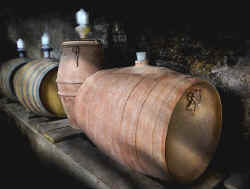 |
The
ancient Greeks and Romans fermented their wine in large clay containers
(dolia) with a capacity of several thousand liters and often partially buried in the
ground. For aging and transport, the wine or wine condensate was sealed
in terracotta amphorae. A similar technique for production is now in experimental use by a very few modern vintners in part as an aspect of the "natural wine" and "slow food" movements. The results have in many cases been extremely good. There's no doubt that fermentation in terracotta can yield new and very fine wine characteristics. |
 |
Josko Gravner, one the foremost innovators in the use of terracotta vessels for grape fermentation, is an esteemed and innovative Friulian winemaker whose vineyards lie in the Friuli-Venezia Giulia region of northeastern Italy straddling the Italian/Slovenian border. From 2001 onwards, he has used huge, bees' wax-lined giare (amphorae - singular "giara") made in Georgia and buried in the ground. The resulting white wines drink more like reds: deeply flavourful, dark in colour and tannic. His three wines are Ribolla, Breg and Rosso Gravner (all IGT Venezia Giulia). The Breg white wine is a blend of Sauvignon Blanc, Riesling Italico, Chardonnay and Pinot Grigio. The Ribolla wine comes from the autochthonous Ribolla Gialla varietal. Rosso Gravner is a blend of merlot and cabernet sauvignon. The reviews are mixed - some rate his whites as the best in Italy. |
 |
At Azienda Agricola Cos at Bastonaca, Vittoria, SE Sicily , fermentation is carried out in terracotta giare (amphoras) of 250 and 400 liters. The wine is made from 40% Frappato di Vittoria and 60% Nero d'Avola (a varietal native to Sicily), and bottled as "Pithos". The reviews are good. |
 |
Az. Agr. Frank Cornelissen, located on the slopes of Mount Etna is another Sicilian property using terracotta giare during fermentation. The grapes are fermented and aged according to ancient traditions in terracotta giare of 400 litres, buried up to the neck in the cellar in ground volcanic rock. There first label is "Magma", and the red is made using Nerello Mascalese grapes. |
 |
Castello di Lispida near Padua was converted from a monastery into a country residence and winery during the 18 C. Towards the end of the 50's, the castle's wine-making activity was given a new lease of life by planting new vines and working to develop and conserve pre-industrial wine-making methods. This included underground amphoras made entirely from terracotta where the fermentation and fining of “Amphora” wine takes place. This was one of the first Italian wines made using the winemaking methods of the Romans. |
 |
Philippe and Alain Viret, owners of Domaine Viret at Saint Maurice/Eygues in France, were inspired to experiment with 420 liter dolia by the quality of the Sicilian wines they tasted that had been stored in amphorae. |

